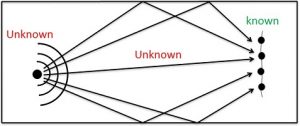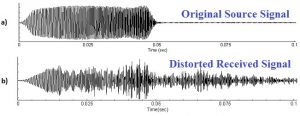Blind Deconvolution
When an acoustic wave travels in a medium which encounters the boundary of a second medium, recorded signals by a receiver array (an array of microphones or hydrophones) is commonly distorted by reflected waves from the boundaries. Such recordings are the convolution of the source signal and the impulse response of environment at the time of signal transmission. “Blind deconvolution” is the name given to the task of determining the source signal and the impulse response from array-recorded signals when the source signal and the environment’s impulse response are both unknown.

Synthetic Time Reversal (STR)
Synthetic time reversal (STR) is a technique for performing blind deconvolution in sound channels in the bandwidth of the source signal to 1) determine the original source signal and the source-to-array-element impulse responses, and 2) localize the remote source. For the first of these two tasks, the additional information used in STR to uniquely estimate the source signal and the environment’s impulse response is drawn from the generic characteristics of the acoustic modes or the acoustic rays that convey sound from the source to the array. Once mode- or ray-based propagation is assumed, no additional assumptions are needed about the form or statistics of the source signal or the environment’s impulse response. Furthermore, STR does not require parametric searches or optimization; its computational burden is only marginally greater than forward and inverse fast-Fourier transformation of the recorded signals. When the first-task effort is successful, the second task becomes possible when basic environmental characteristics are known at the receiving array, and the range-dependence of the underwater environment is mild.
Here, findings are based on underwater experiments involving source-array ranges of 250 m in 60-m-deep water and chirp signals with a bandwidth of 1.5 to 4.0 kHz. The receiving array has 32 pressure sensors with uniform 22.4 cm spacing between the elements. Signal estimation performance is quantified by the correlation coefficient between the source-broadcast and the STR-estimated signals. The figure below (part a) shows the measured broadcast signal and part b is the signal recorded by the first (shallowest) element of the receiving array.

The figure below is the STR reconstructed source signal. Here, STR provides a noticeable improvement in the signal envelope shape over the single-receiver. The cross correlation coefficient of this signal with the broadcast signal is 99%.
